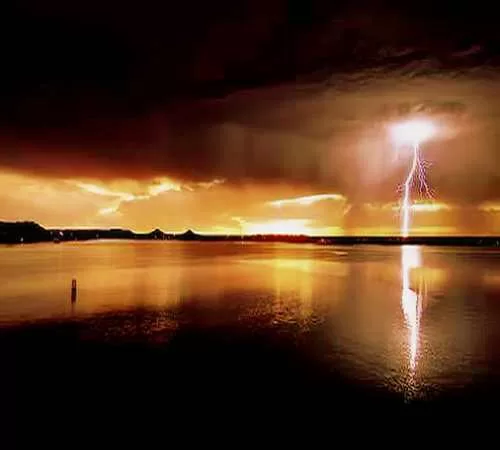For those who have ventured to the stilt houses in the southern reaches of Lake Maracaibo, the mysterious natural spectacle known as Catatumbo Lightning, or “El Relámpago del Catatumbo” in Spanish, is an awe-inspiring experience. This phenomenon, characterized by its frequent, thunderless lightning, has captivated the imagination and wonder of all who witness it.
The Marvel of Catatumbo Lightning
Located where the Catatumbo River meets Lake Maracaibo in Venezuela, Catatumbo Lightning is a unique natural phenomenon. It manifests as cloud-to-cloud lightning arcs that can reach over five kilometers high. Occurring on 140 to 160 nights a year, each lightning storm can last up to 10 hours and flash up to 280 times per hour. This remarkable display takes place over the marshlands where the Catatumbo River feeds into Lake Maracaibo, making it one of the most reliable and significant generators of ozone on the planet due to its intensity and frequency.
An Electrical Spectacle
With an estimated 1,176,000 electrical discharges per year, Catatumbo Lightning generates an intensity of up to 400,000 amperes. Visible from up to 400 kilometers away, it has earned the nickname “Maracaibo Beacon” because its light has historically been used by ships for navigation. The storms result from the collision of winds from the Andes Mountains with ionized gases, particularly methane released by decomposing organic matter in the marshes. Lighter than air, this gas rises into the clouds, fueling the persistent lightning storms.
A Natural Wonder Worth Protecting
Local environmentalists are advocating for the Catatumbo Lightning area to receive UNESCO protection, highlighting its exceptional nature and its role in regenerating the planet’s ozone layer. The lightning can be seen on average 160 nights a year, with the storms lasting up to 10 hours and producing up to 280 lightning flashes per hour.
Historical Accounts and Scientific Fascination
The German scientist and explorer Alexander von Humboldt was among the first to document Catatumbo Lightning, bringing it to the world’s attention. He described the phenomenon as “electrical explosions that are like a phosphorescent gleam,” referring to it as “El Farol de Maracaybo” or “The Lighthouse of Maracaibo.” Humboldt noted that navigators on Lake Maracaibo used the lightning as a natural lighthouse, visible from more than 40 leagues away.
In his renowned book “Travels to the Equinoctial Regions of America,” Humboldt wrote about the consistent nature of the lightning, attributing it to the daily occurrence of electrical storms in the region. Despite its visibility from hundreds of miles away, the primary area where Catatumbo Lightning occurs is the sky over the mouth of the Catatumbo River, as it flows into the southern part of Lake Maracaibo, known in Spanish as Sur del Lago.
Experiencing Catatumbo Lightning
Tourists eager to witness this natural wonder typically start their journey from Merida, traveling to the small fishing village of Puerto Concha on the shores of Sur del Lago. From there, boat trips are arranged to the houses on stilts in the Las Cienagas de Juan Manuel National Park, offering the best views of the lightning. One notable community is Congo Mirador, consisting of about 120 stilt-built shacks, accessible by a two-hour boat ride from Puerto Concha.
The Mystery Behind the Phenomenon
Despite extensive study, there is no single accepted explanation for Catatumbo Lightning. Most theories link it to the unique atmospheric conditions created by the strong winds blowing down from the Andes Mountains, which then collide with ionized gases like methane from the local marshes. These interactions create the electrical discharges that result in the stunning lightning displays.
Conclusion
Catatumbo Lightning remains one of the world’s most fascinating natural phenomena, combining elements of meteorology, geography, and atmospheric science. Its near-permanent presence and the sheer scale of its electrical discharges make it a subject of continuous intrigue and study. For those seeking a unique travel experience, witnessing Catatumbo Lightning offers a chance to see nature’s power in one of its most spectacular forms.
As efforts continue to protect and understand this phenomenon, Catatumbo Lightning stands as a testament to the awe-inspiring forces of our planet, reminding us of the beauty and mystery that nature holds. Whether for scientific interest or sheer wonder, Catatumbo Lightning is a sight that leaves an indelible impression on all who experience it.

